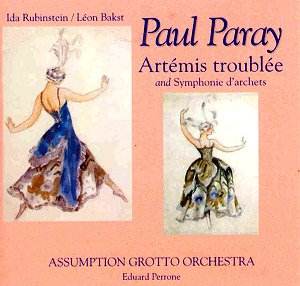The presentation of
these Grotto Productions CDs is uncompromisingly
thorough. They evince passion rather
than mere enthusiasm. Music examples,
illustrations, bibliographies join,
in the case of the Artémis
score, extensive background on the
plot, original dancers, choreographer,
designer and director.
Artémis
Troublée is represented
here by an extensive five movement suite.
Its danceability is clearly a concern
of Fr Eduard Perrone who not for one
moment loses touch with the work's choreographical
and stage origins. Loosely speaking
the style of Paray's beguiling music
is along the lines of Florent Schmitt
(Tragédie de Salomé),
Stravinsky (Firebird) and Balakirev
(Tamara) but textures are cleaner,
less dense, less affluent. It as if
the voluptuousness of these scores beloved
of Diaghilev and Leon Bakst was transformed
and lightened by a Ravel-like concern
for clarity. It is all very attractive
and there is clearly no reason why this
score should have been so shamefully
forgotten until now. While it may have
become a vehicle for the sensuously
inclined Ida Rubinstein it does not
deserve the ephemeral reputation to
which it has been treated until this
recording appeared.
The plot is from Greek
classical sources and has the mortal
hunter Actaeon seeing the huntress goddess
Artemis bathing and falls in love with
her. Finally she submits to Actaeon's
advances but Zeus and Artemis's immortal
companions will have none of this. She
is tricked into firing an arrow at what
she takes to be a stag. It is Actaeon
who pierced through the heart is killed.
Artemis stands torn between absorption
in her divinity and the pain of love
lost.
The five movements
are Les belles éconduite (jaunty
yet sinuously lyrical), La rencontre
(a lovingly insistent yet hesitant
romance - Rimsky's Sheherazade
and Balakirev's Thamar), Les
flêches de carquois (part
way between Ravel's Daphnis,
Poulenc's Les Biches and Tchaikovsky
Valse des fleurs), L'aveu
dans le soir (magical bell effects
from the woodwind and an increasingly
ardent duet with the viola principal)
and Les présents merveilleux
(jaunty, catchy and Poulenc-like
with less of the exotic and more of
the flavour of rural France).
The Symphonie
d'Archets is the composer's
own orchestration of his string quartet.
The quartet was written while Paray
was a prisoner of war in Darmstadt in
1915 where he was confined until the
end of the war in 1918. The quartet
is recorded with other chamber works
by Paray on another Grotto Productions
disc.
All the signs are that
by 1940 Paray had sloughed off his ambitions
as a composer and devoted himself to
conducting. His Second Symphony, written
in 1939, was to be his last work. However
in 1944 conducting became impossible
under wartime conditions so he turned
to his thirty year old quartet and orchestrated
it as a Symphony for Strings. It was
premiered in Monte Carlo, with Paray
conducting, on 19 March 1944.
This four movement
work bears the Franckian imprint. The
music is superbly laid out for the string
orchestra although the textures are
not as translucent as those in Artémis
Troublée. In the second movement
the mood is elegiac, recalling somewhat
Grieg's Last Spring and Holberg.
The final two movements skip along happily
with engaging antiphonal dialogue and
airy zephyr effects as at (tr. 8 00.50).
The last movement is more heavily shod,
dignified and with a hint of the sort
of pastoralism reflected in Poulenc's
Suite Francaise.
Recorded with both
sensitivity and attention to the varying
weight of texture.
Not to be missed by
lovers of French classical music who
appreciate both a cooler classical approach
as well as the sultry climes of Ballets
Russes. The Symphony will be welcomed
by anyone with an interest in the similar
string works of Florent Schmitt (Janiana)
and Jean Rivier.
Rob Barnett


